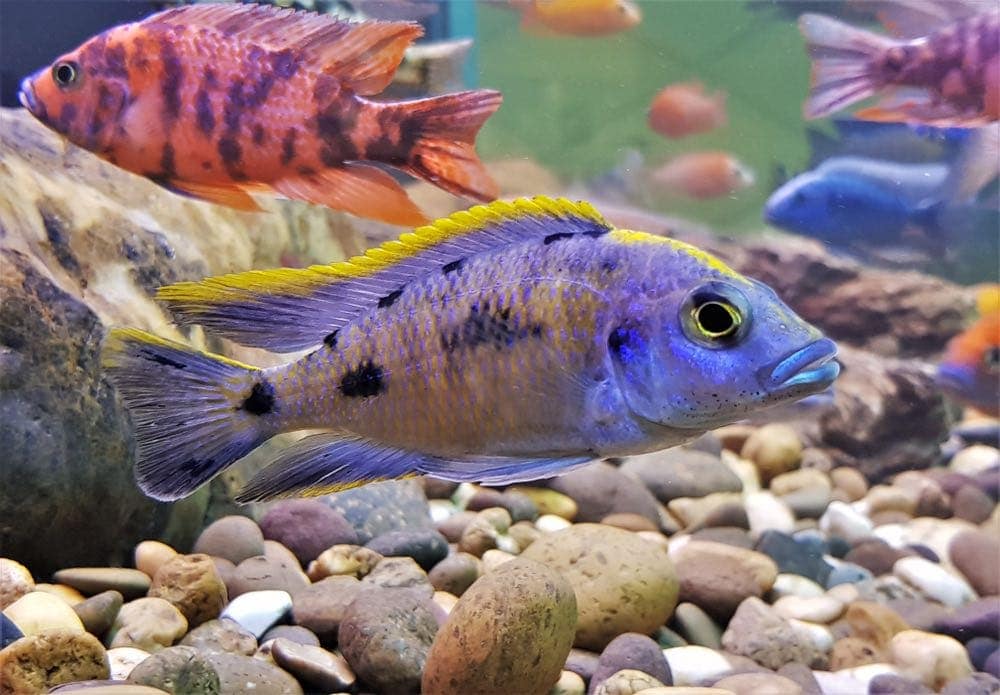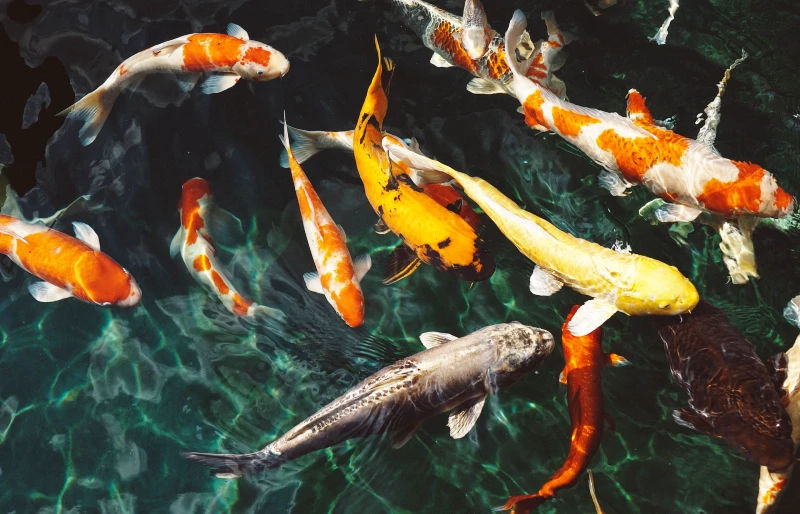11 Tank Mates for Silver Dollar Fish (With Pictures)
Updated on
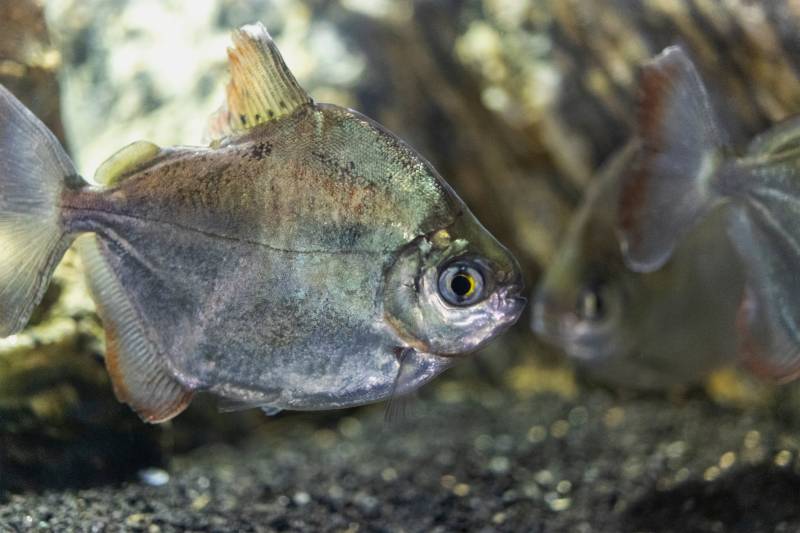
Click to Skip Ahead
The 11 Best Tank Mates for Silver Dollar Fish
1. Silver Dollar Fish (Metynnis sp.) – Top Pick

| Size: | 4–8 inches (10–20 centimeters) |
| Diet: | Herbivore |
| Minimum tank size: | 75 gallons (284 liters) |
| Care Level: | Medium |
| Temperament: | Peaceful, timid |
The number one tank mate for silver dollar fish is another silver dollar fish! In fact, these fish should never be kept singularly. For schooling fish, being kept alone or in very small groups can be stressful. Aim to keep at least six silver dollar fish together at a time, but your fish will happily live in larger groups of 15 or more.
Silver dollars do require quite a bit of tank space, with the minimum tank size being 75 gallons, although some people recommend 100 gallons or more. These fish are peaceful but can be quite shy around more boisterous fish or if kept in very small groups.
2. Bristlenose Plecostomus (Ancistrus dolichopterus)

| Size: | 4–5 inches (10–12 centimeters) |
| Diet: | Herbivore |
| Minimum tank size: | 20 gallons (75 liters) |
| Care Level: | Easy |
| Temperament: | Docile, social |
The bristlenose plecostomus is a docile fish that is great for beginners, and it’s a unique, fun addition to your silver dollar tank thanks to its bristly nose. These fish stay smaller than some of their plecostomus cousins, so they require less tank space and create a lower bioload.
They are herbivorous fish that will spend most of their time at the bottom of the tank. Don’t count on the bristlenose to clear your tank of algae, though, and always remember to feed them.
3. Corydoras Catfish (Corydoras sp.)
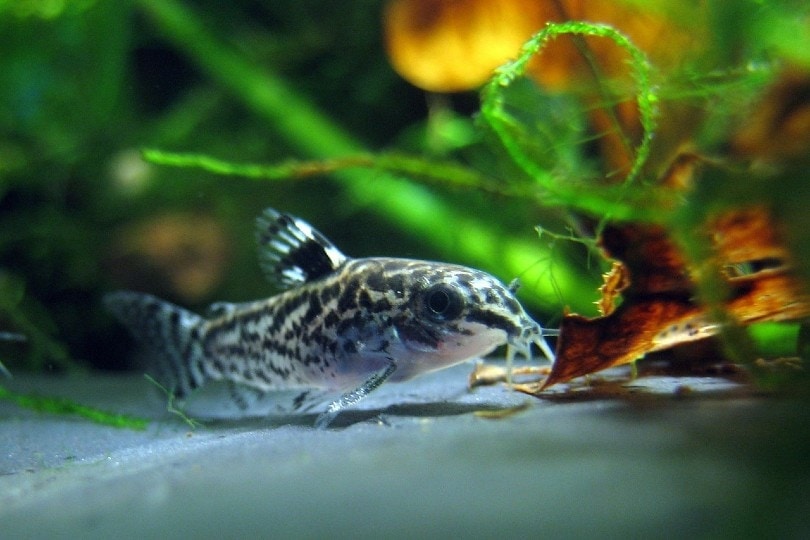
| Size: | 1–3 inches (2.5–7.5 centimeters) |
| Diet: | Omnivore |
| Minimum tank size: | 20 gallons (75 liters) |
| Care Level: | Easy |
| Temperament: | Peaceful, calm |
The corydoras catfish is a small catfish that, believe it or not, prefers to live in groups. Always keep at least six corys together. Without a group, these fish tend to be extremely timid and fearful, and the lack of companions can make them stressed and ill. They tend to mind their own business, sticking to other corys and leaving their tank mates alone.
4. Kuhli Loach (Pangio kuhlii)
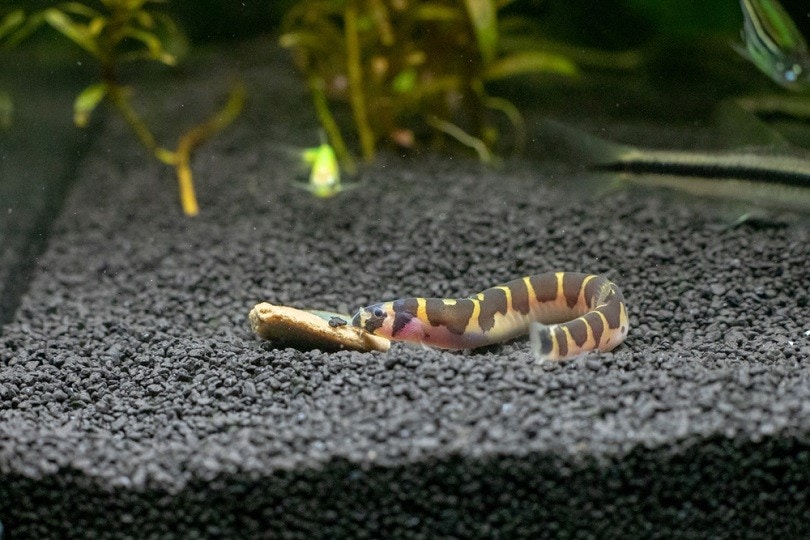
| Size: | 3–4 inches (7.5–10 centimeters) |
| Diet: | Carnivore |
| Minimum tank size: | 20 gallons (75 liters) |
| Care Level: | Easy |
| Temperament: | Peaceful, social |
The kuhli loach is an adorable loach species that doesn’t get very large. They do tend to have big personalities, though, but you’ll need a group of at least six kuhlis for them to feel safe. They are social fish, but without hiding spots and companions, they can become highly stressed.
Some kuhlis may stay hidden most of the time, choosing only to come out for meals or at night, but if you keep an eye out, you may spot their little heads sticking out of unusual hiding places.
5. Red Belly Pacu (Piaractus brachypomus)

| Size: | 12–24 inches (30–61 centimeters) |
| Diet: | Herbivore |
| Minimum tank size: | 200 gallons (757 liters) |
| Care Level: | Medium to hard |
| Temperament: | Peaceful, brave |
If you thought the silver dollar fish looks like a piranha, check out the red belly pacu! Like the silver dollar, these fish are in the same family as piranhas, but these fish are herbivores. If you’ve ever had a chance to see the teeth of a red belly pacu, it can be a strange experience because they look so much like human teeth.
Even though they can get extremely large and require very large tanks, the red belly pacu is a generally peaceful fish, although it isn’t too shy to stand up for itself if its tank mates are bullies!
6. Silver Zebra Angelfish (Pterophyllum scalare)
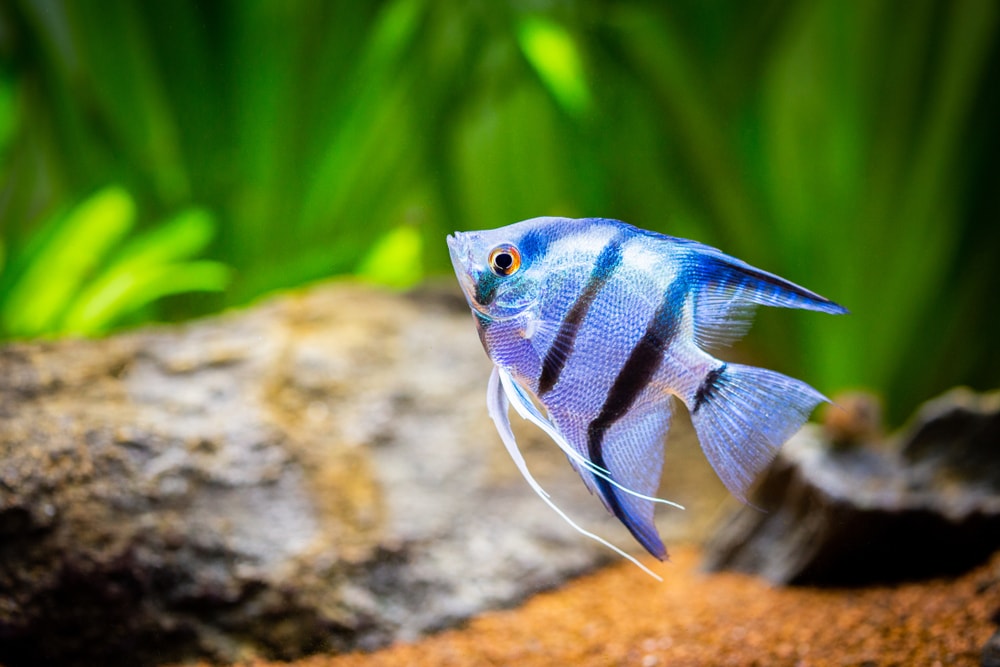
| Size: | 2–12 inches (5–30 centimeters) |
| Diet: | Omnivore |
| Minimum tank size: | 30 gallons (114 liters) |
| Care Level: | Medium |
| Temperament: | Relatively peaceful, territorial |
The silver zebra angelfish shouldn’t be confused with the saltwater angelfish species. These freshwater fish are actually a type of cichlid, but the silver zebra tends to be one of the most peaceful cichlid species you can get. They prefer to be kept in groups, but as they age, they may become territorial, especially if the tank is crowded, so be prepared to split them up or get a larger tank if needed. In general, they are peaceful toward their other tank mates.
7. German Blue Ram (Mikrogeophagus ramirezi)

| Size: | 2–2.5 inches (5–6.4 centimeters) |
| Diet: | Omnivore |
| Minimum tank size: | 20 gallons (75 liters) |
| Care Level: | Medium |
| Temperament: | Generally peaceful, territorial |
The German blue ram is another cichlid variety that is suitable for community tanks. They are peaceful, not to mention beautiful fish. They stay small, so they don’t require a lot of space, but they do need enough room to create their own territories.
They can become very protective of their territory, especially when eggs are present. Interestingly, they may show some aggression toward tank mates that are of similar size and color to them, likely mistaking them for competition.
8. Clown Loach (Chromobotia macracanthus)
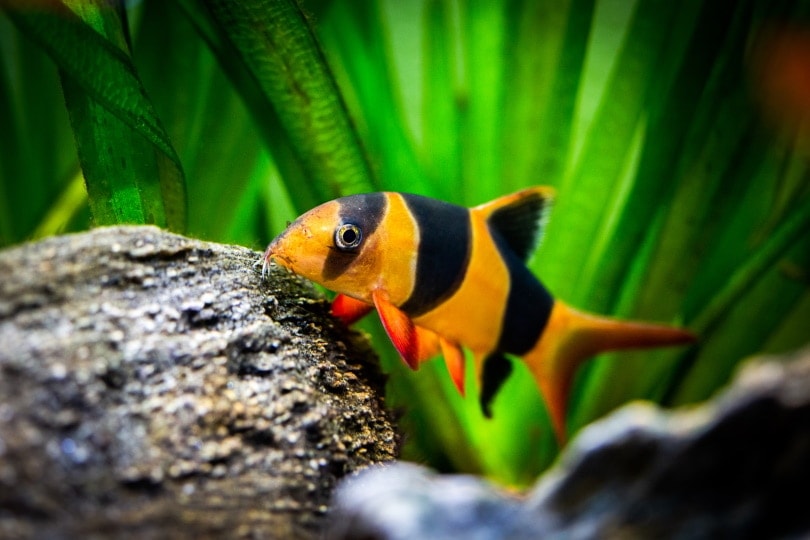
| Size: | 6–12 inches (15–30 centimeters) |
| Diet: | Omnivore |
| Minimum tank size: | 100 gallons (379 liters) |
| Care Level: | Medium to hard |
| Temperament: | Relatively peaceful, easy-going |
The clown loach is an interesting loach variety that should be kept in groups of six or more fish. If kept alone or in small groups, they may become aggressive. They do typically stick together in schooling fish fashion, with a female fish as the leader of the group. These fish can get very large, and due to the risk of territorial behavior, it’s essential to have a large enough tank to manage these big fish.
9. Rosy Barb (Pethia conchonius)
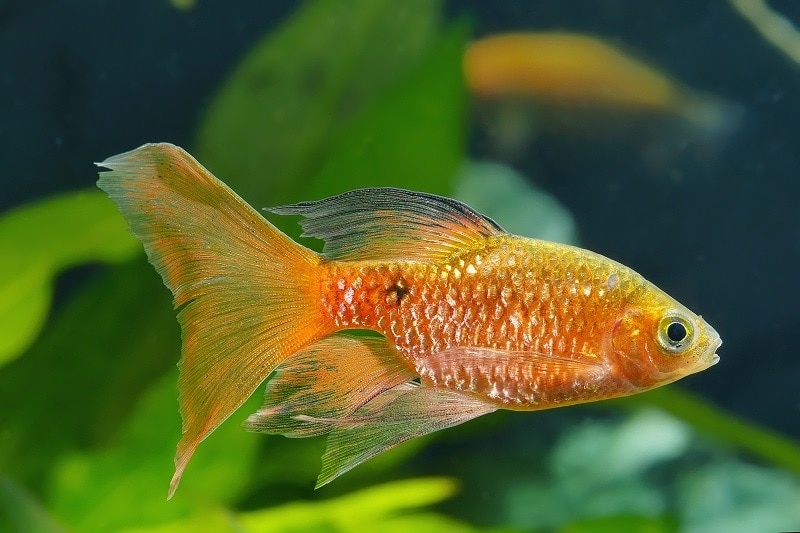
| Size: | 2.5–6 inches (6.4–15 centimeters) |
| Diet: | Omnivore |
| Minimum tank size: | 20 gallons (75 liters) |
| Care Level: | Medium |
| Temperament: | Peaceful, social |
The rosy barb is a lovely barb that is quite peaceful, making it suitable for your silver dollar tank. These fish need to be kept in groups of six or more fish, and when kept in small groups, may show signs of stress or aggression, but they are a great addition to community tanks.
They can reach up to 6 inches in length, so it’s important to make sure they have enough space, and even though their minimum tank size is 20 gallons, it’s recommended to give them more space than this.
10. Dwarf Gourami (Trichogaster lalius)
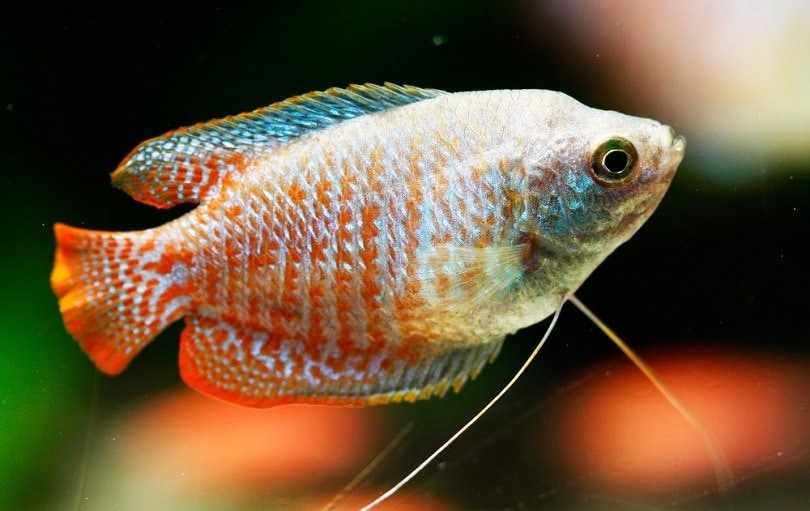
| Size: | 2–3.5 inches (5–9 centimeters) |
| Diet: | Omnivore |
| Minimum tank size: | 10 gallons (38 liters) |
| Care Level: | Medium |
| Temperament: | Peaceful, easy-going |
The dwarf gourami is a brightly colored fish that stays relatively small and doesn’t require much space. Their peaceful nature makes them a good pick for community tanks, and they are schooling fish that need a group of at least four fish to feel secure.
It’s not uncommon for males to show some territorial or mildly aggressive behavior to brightly colored tank mates that they mistake as competition, but they typically keep to themselves.
11. Black Ghost Knife (Apteronotus albifrons)

| Size: | 18–20 inches (46–51 centimeters) |
| Diet: | Carnivore |
| Minimum tank size: | 100 gallons (379 liters) |
| Care Level: | Medium |
| Temperament: | Active, docile |
The black ghost knife is a unique and interesting fish that spends most of its time near the bottom of the tank, hiding in caves. Due to their poor eyesight, these fish use electrical signals to hunt for food, and they are true carnivores. However, they tend to keep to themselves, staying away from their tank mates. They are docile fish that some people report becoming “friendly” with their owner, sometimes approaching the front of the tank, or touching their hand when in the tank for maintenance.
What Makes a Good Tank Mate for Silver Dollar Fish?
Ideal silver dollar fish tank mates should be peaceful fish that are appropriate for community tanks. Keep in mind that even some peaceful fish can become aggressive in an overcrowded tank, so ensure you have plenty of space for all of the tank’s inhabitants to live happily. Other suitable tank mates are bottom dwellers since they will not cross paths with the silver dollars very often.

Where Do Silver Dollar Fish Prefer to Live in the Aquarium?
Silver dollar fish are middle to top dwellers, as is common with schooling fish. They will likely spend a lot of time in the middle of the water column, only coming to the surface when there is food present.
Water Parameters
Silver dollar fish are tropical fish that originated in South America, so they need tropical water parameters. They should be kept in a heated tank with temperatures from 75–82°F (24–28°C). Like many South American fish, they prefer slightly acidic to neutral tank pH, from 5.0–7.0. They can tolerate water hardness up to around 15–18dGH.
Make sure to provide plants and hiding places, but keep in mind that the silver dollar is known for uprooting plants, so enlist the help of plant weights, substrate, pots, aquarium glue, and fishing line to keep your plants in place.
Size
The silver dollar fish is a decently sized fish, reaching 4–8 inches in length by adulthood. Because of their large size and need to be kept in groups, it’s important to ensure that your silver dollars are in a tank that is at least 75 gallons by the time they reach adulthood. A small tank may work while they are young, but at least 75 gallons is necessary to keep them happy and healthy as adults.
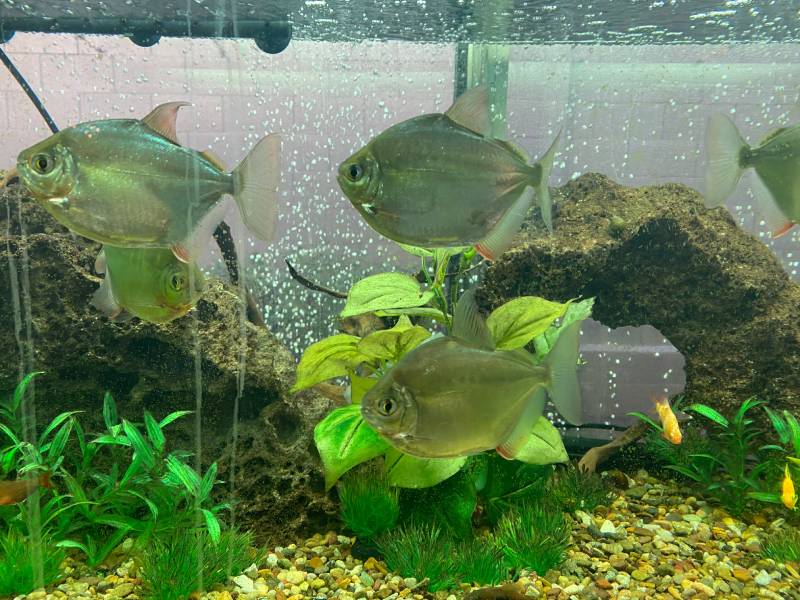
Aggressive Behaviors
Not only is the silver dollar fish not aggressive, but it can actually be quite timid. Aggressive and bullying tank mates may cause your silver dollars to be very shy, while more laidback tank mates are likely to bring out the more relaxed side of the silver dollars. Although peaceful herbivores, it’s not completely unheard of for silver dollar fish to eat tank mates they can fit in their mouths.
The 2 Benefits of Having Tank Mates for Silver Dollar Fish
1. They Balance the Tank’s Appearance
Because silver dollars spend all of their time in the middle and upper regions of the tank, they can help to balance the overall appearance of your tank. This is especially true if your tank is already populated with groups of bottom feeders or one or two large bottom-dwelling fish.
2. They Can Support Substrate Health
While it can be extremely annoying to deal with a fish uprooting plants all the time, the silver dollar fish’s habit of uprooting plants can help support the substrate health. For rooted plants, uprooting can help to turn over the substrate, reducing the buildup of gases underneath the substrate and help support the health of the beneficial bacteria in the tank.
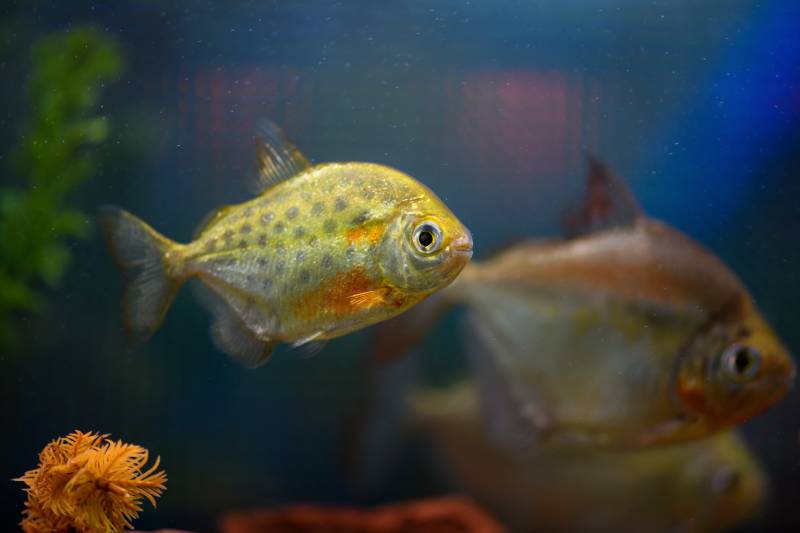
Conclusion
Silver dollar fish are peaceful fish that can be great tank mates to a variety of other fish, but they should always be kept in groups of six or more for their own health and happiness. Without a shoal, silver dollars are extremely timid and jumpy, and they can experience significant stress.
While very peaceful, it is a possibility for silver dollars to eat small tank mates, so make sure to pair them with tank mates that are too large to be eaten and avoid small fish, like ember tetras and chili rasboras.
Featured Image Credit: Another77, Shutterstock


